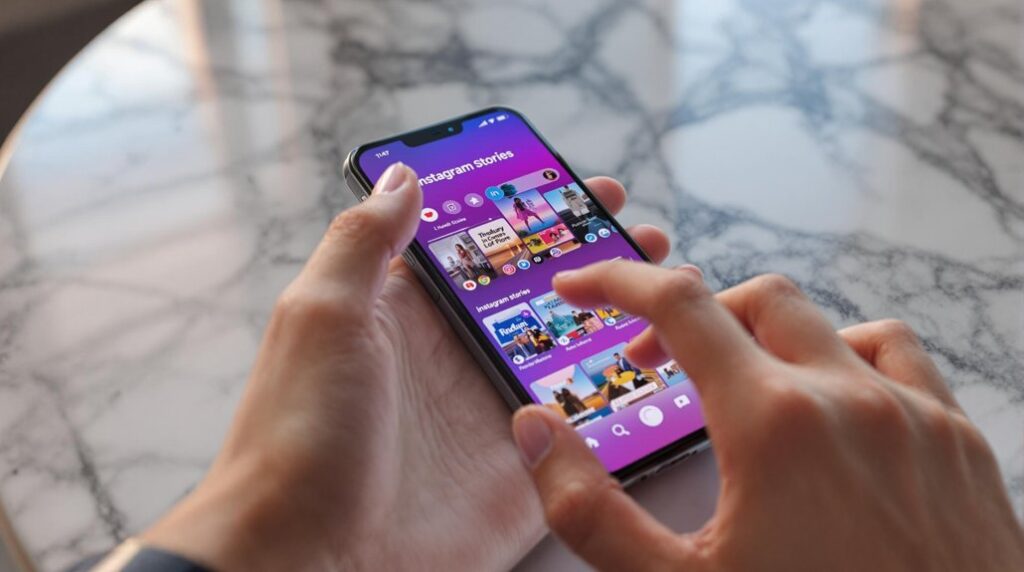To master Instagram influencer marketing, businesses should identify ideal influencers, prioritizing micro influencers with 10,000 to 100,000 followers for high engagement and cost-effectiveness. Clearly defined campaign goals are critical, with 86% of marketers using influencer strategies to align with their strategic vision. Authentic collaborations heighten ROI by 11 times, stressing the importance of shared values. Engaging content, particularly visual and user-generated, can spike engagement by up to 28%. Finally, performance metrics like conversion rates guide strategy refinement, with influencer content yielding roughly $5.20 per dollar spent. Understanding these strategies can greatly boost your brand’s visibility and impact.
Key Takeaways
- Collaborate with micro-influencers to increase engagement and cost-effectiveness within the 18-24 age demographic.
- Set clear campaign goals, using measurable KPIs to evaluate success and optimize ROI.
- Foster authentic collaborations by aligning brand values and allowing creative freedom in content creation.
- Leverage visually engaging content, such as stories and reels, and include interactive elements like polls to boost audience participation.
- Measure performance using metrics like reach, engagement, and conversion rates to refine strategies and optimize budget allocations.
Identify Ideal Influencers
When identifying ideal influencers for your Instagram marketing strategy, focusing on micro influencers—those with 10,000 to 100,000 followers—can be particularly advantageous due to their higher engagement rates and cost-effectiveness compared to macro influencers.
These influencers often exhibit engagement rates between 1%-5%, indicating a strong connection with their audience, vital for influencing purchasing decisions. As Instagram users, particularly those aged 18-24, are highly engaged with influencer content, aligning with micro influencers can effectively target this demographic.
To guarantee alignment with your marketing objectives, assess relevant influencers based on their content quality and authenticity. Authenticity in an influencer’s content fosters trust and relatability, essential for driving consumer interest.
Social listening platforms can be instrumental in identifying influencers who naturally discuss your industry or brand, guaranteeing a seamless integration into your marketing strategy.
Furthermore, consider the audience demographics of potential influencers to confirm they align with your target market. This strategic alignment helps maximize reach and impact, particularly in engaging younger consumers who are pivotal in digital marketing trends.
Set Clear Campaign Goals
Why is setting clear campaign goals a fundamental step in influencer marketing strategies on Instagram? Establishing precise objectives, such as enhancing brand awareness or boosting sales, is pivotal in directing the overall influencer marketing strategy. Research reveals that 86% of social marketers focus on influencer marketing to achieve goals that align with their brand’s strategic vision. By setting clear campaign goals, businesses can tailor their efforts to engage the target audience effectively.
Effective goal-setting involves identifying measurable Key Performance Indicators (KPIs) like engagement rates, reach, and conversion rates, which are essential for evaluating campaign success. For example, 75% of Instagram users aged 18-24 following at least one influencer underscores the platform’s potential for engaging younger demographics. This data highlights the importance of aligning campaign goals with the target audience’s interests and preferences.
| Metric | Importance |
|---|---|
| Engagement Rates | Measures audience interaction and interest |
| Reach | Indicates the scope of audience exposure |
| Conversion Rates | Evaluates the effectiveness in driving sales |
Setting defined goals guarantees that influencer partnerships are optimized, allowing businesses to precisely evaluate the return on investment (ROI) for their marketing efforts. In doing so, companies enhance their ability to measure campaign success and refine their influencer marketing strategy effectively.
Foster Authentic Collaborations
In today’s digital marketing landscape, fostering authentic collaborations with influencers on Instagram is paramount for achieving meaningful engagement and impressive ROI. Brands that align their values and target audiences with influencers experience up to 11 times higher ROI.
Authentic collaborations are not just about numbers; they focus on genuine connections that resonate with followers. Allowing influencers creative freedom in content creation enhances relatability and authenticity, making their endorsements appear genuine. Clear communication about campaign goals is essential, guaranteeing influencers grasp the brand’s message while maintaining their unique voice.
Research underscores the importance of authenticity, with 86% of consumers prioritizing it when choosing brands. Collaborating with micro-influencers, known for their loyal audiences, offers enhanced authenticity and stronger connections within niche markets. These influencers excel in producing influencer-generated content that aligns with brand values.
- Align influencers with brand values: Choose influencers who genuinely resonate with your brand’s ethos and target audience.
- Encourage creative freedom: Allow influencers to craft content that reflects their style, fostering authenticity.
- Maintain clear communication: Set clear campaign goals to guarantee understanding while respecting the influencer’s voice.
Conclusively, authentic collaborations drive higher engagement rates and nurture sustainable brand-influencer relationships.
Leverage Engaging Content
Leveraging engaging content on Instagram is a critical strategy for maximizing audience interaction and driving brand success. With 93% of consumers valuing visual content over text, utilizing elements such as stories, reels, and visually appealing posts becomes indispensable.
Influencer collaborations that focus on storytelling can boost engagement rates by 22%, as they create a narrative that resonates deeply with audiences. This trend underscores the power of crafting relatable and emotionally compelling content.
Moreover, integrating user-generated content (UGC) into influencer campaigns can result in a 28% increase in engagement. UGC offers authentic experiences that audiences perceive as genuine, strengthening their connection to the brand.
Enhancing posts with clear calls-to-action (CTAs) can further raise conversion rates by up to 20%, guiding followers to immediate action and driving measurable results.
Incorporating interactive elements like polls or quizzes within Instagram Stories can amplify audience participation by 40%. This approach not only makes content more memorable but also encourages active user involvement.
Measure Performance Metrics
To truly gauge the effectiveness of Instagram influencer marketing strategies, understanding and analyzing performance metrics is essential. Businesses should prioritize measuring metrics such as reach, engagement (likes, comments, shares), website clicks, and conversion rates to assess the impact of influencer marketing campaigns.
Utilizing Instagram Insights is a strategic approach to decode audience demographics and engagement metrics, offering a clearer picture of campaign success. This data-driven analysis aids in optimizing social media budget allocations for maximum return on investment.
A notable finding reveals that influencer-generated content often surpasses brand-directed materials, delivering a return of approximately $5.20 for every dollar spent. As a result, tracking direct sales through unique promo codes or affiliate links is vital to quantifying the financial effectiveness of these campaigns.
To further enhance understanding, consider the following:
- Instagram Insights: Analyze audience demographics, impressions, and engagement rates to refine strategies.
- Conversion Rates: Monitor changes to determine how effectively influencers drive desired actions.
- Return on Investment: Compare engagement rates against social media budget allocations for informed decision-making.
Frequently Asked Questions
What Are the 3 R’s of Influencer Marketing?
The 3 R’s of influencer marketing—Reach, Relevance, and Relationships—are essential for audience engagement, content authenticity, and brand alignment. Influencer selection, campaign measurement, niche targeting, trust building, creative storytelling, and long-term partnerships enhance these collaborative models.
What Is the Best Strategy for Influencer Marketing?
The best strategy for influencer marketing involves leveraging micro influencer partnerships, focusing on authenticity in marketing, utilizing storytelling in campaigns, and employing niche targeting methods. Prioritize long-term collaborations and analyze performance metrics while ensuring ethical considerations and brand alignment.
What Is the Business Model of Instagram Influencers?
The business model of Instagram influencers focuses on influencer income through brand partnerships, leveraging audience engagement and content creation. Niche targeting, social proof, and trust building enhance campaign effectiveness, while market trends and follower growth drive sustained success.
How to Do Instagram Influencer Marketing?
To execute effective Instagram influencer marketing, define campaign goals, conduct authenticity verification, and guarantee brand alignment. Focus on target audience engagement metrics, strategic content creation, influencer outreach, and relationship building, while leveraging platform analytics and mindful budget planning.
Conclusion
To sum up, implementing effective Instagram influencer marketing strategies necessitates the identification of ideal influencers, the establishment of clear campaign goals, the fostering of authentic collaborations, the leveraging of engaging content, and the measurement of performance metrics. These strategies are imperative for businesses aiming to enhance brand visibility and consumer engagement. By aligning with current trends and utilizing data-driven insights, businesses can optimize their marketing efforts, thereby achieving a competitive edge in the dynamic landscape of social media marketing.




